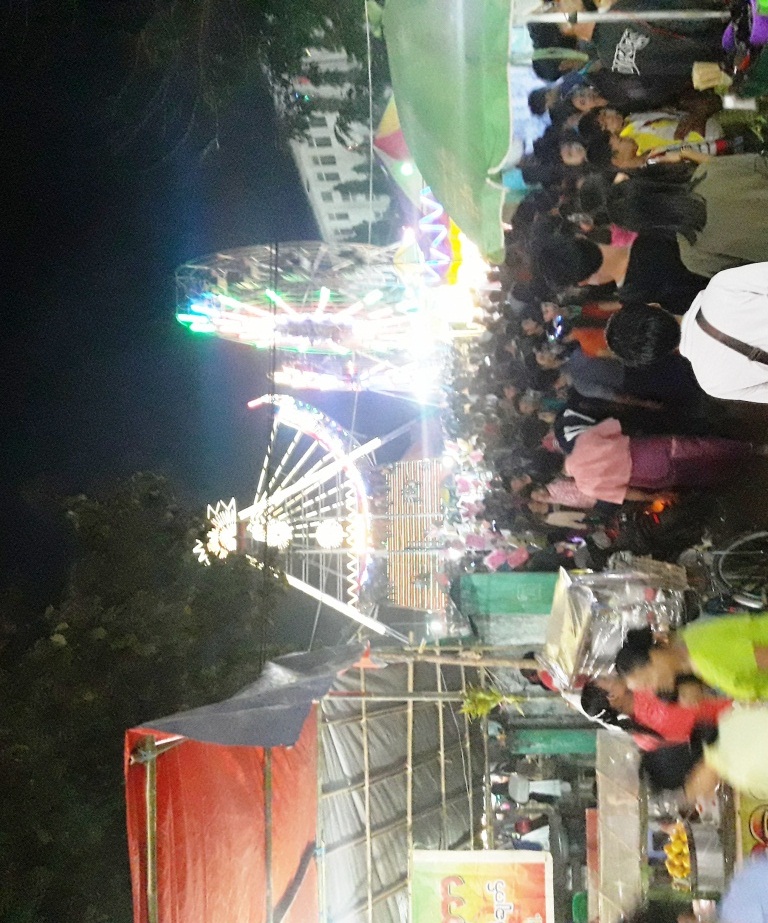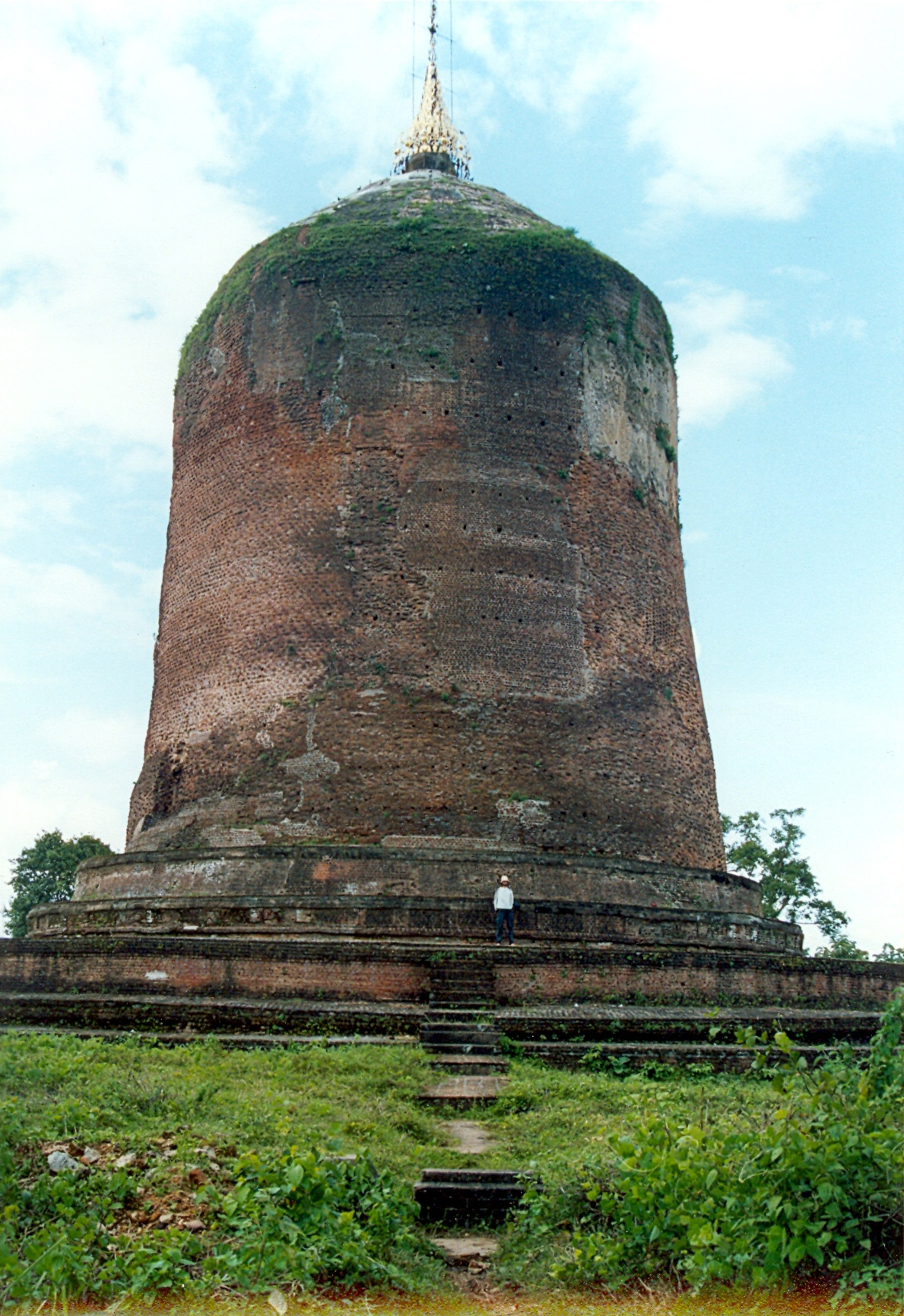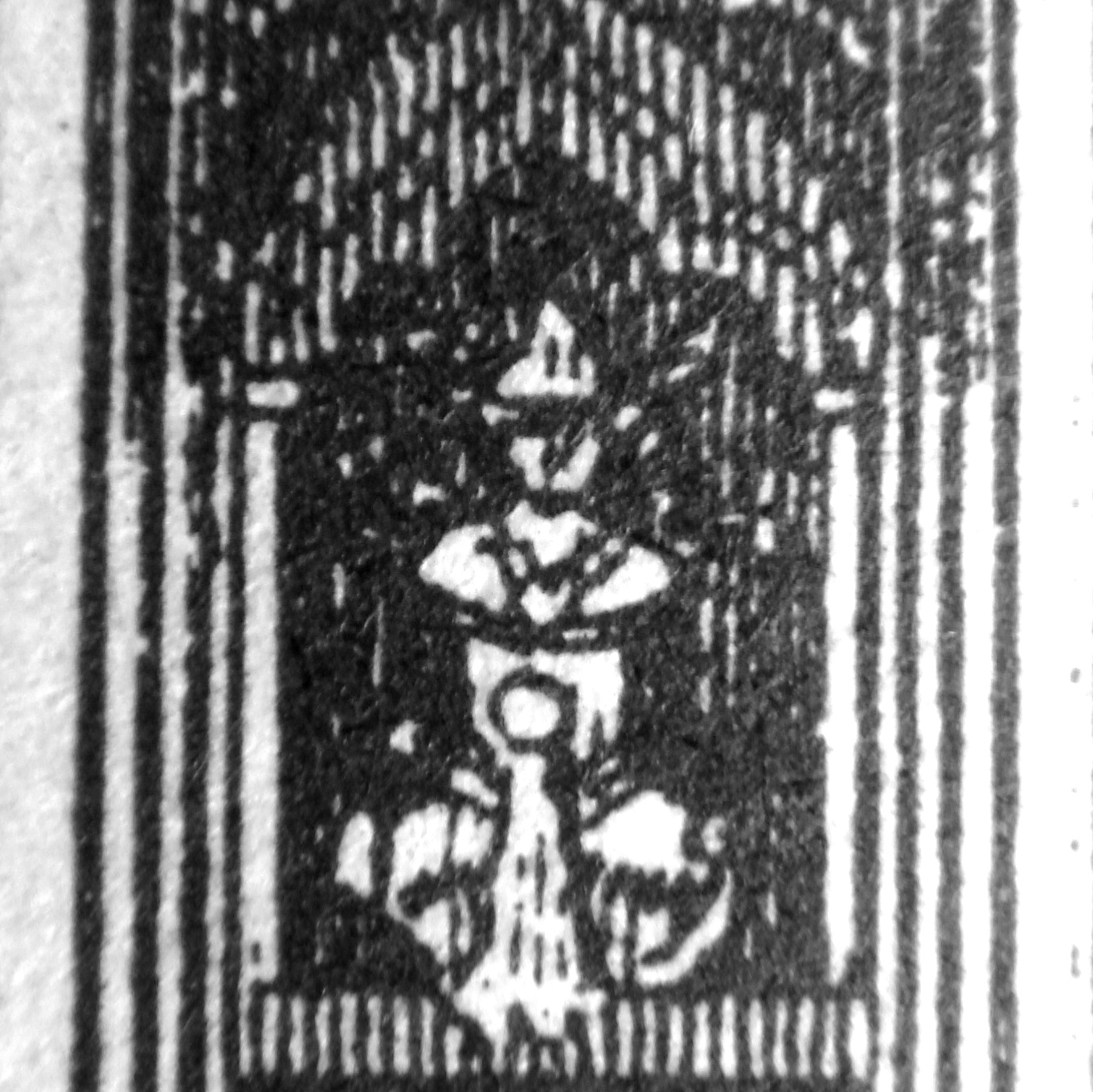|
Shwemawdaw Pagoda
The Shwemawdaw Pagoda ( my, ရွှေမောဓော ဘုရား ; mnw, ကျာ်မုဟ်တ ) is a stupa located in Bago, Myanmar. It is often referred to as the Golden God Temple. At in height, the Shwemadaw holds the record for the tallest pagoda in the country although the Shwedagon Pagoda in Yangon is usually credited as the tallest pagoda in Myanmar (at ). Shwemadaw, along with the Shwedagon and Kyaiktiyo, are famous Mon pagodas. The annual pagoda festival is a 10-day affair that takes place during the Burmese month of Tagu. History The Shwemawdaw Paya was originally built around the 10th century, C.E. It was destroyed several times due to earthquakes, including one in 1917 and another in 1930. Portions of the fallen pre-1917 version of the Paya remain at the site. The original version of the pagoda was approximately tall, built by the Mon supposedly to hold two hairs of the Buddha. Allegedly, the hairs were given personally to two Mon merchants named ... [...More Info...] [...Related Items...] OR: [Wikipedia] [Google] [Baidu] |
Buddhism
Buddhism ( , ), also known as Buddha Dharma and Dharmavinaya (), is an Indian religion or philosophical tradition based on teachings attributed to the Buddha. It originated in northern India as a -movement in the 5th century BCE, and gradually spread throughout much of Asia via the Silk Road. It is the world's fourth-largest religion, with over 520 million followers (Buddhists) who comprise seven percent of the global population. The Buddha taught the Middle Way, a path of spiritual development that avoids both extreme asceticism and hedonism. It aims at liberation from clinging and craving to things which are impermanent (), incapable of satisfying ('), and without a lasting essence (), ending the cycle of death and rebirth (). A summary of this path is expressed in the Noble Eightfold Path, a training of the mind with observance of Buddhist ethics and meditation. Other widely observed practices include: monasticism; " taking refuge" in the Buddha, the , and the ; ... [...More Info...] [...Related Items...] OR: [Wikipedia] [Google] [Baidu] |
Pagoda Festival
Pagoda festivals ( my, ဘုရားပွဲ; ''paya pwe'') are regular festivals found throughout Burma (Myanmar) that commemorate major religious events in pagoda's history, including the founding of a pagoda and the crowning of the pagoda's hti (umbrella). Pagoda festivals are dictated by the Burmese religious calendar and often are held several days at a time. Major events in a pagoda festival typically do not coincide with Uposatha (Buddhist Sabbath) days, during which pious Buddhists observe the Eight Precepts. The majority of pagoda festivals are held during the dry season, from the months of Tazaungmon (November) to Tabaung (March). During the full moon day of Tabaung (Magha Puja), Buddhist devotees in various parts of Myanmar also celebrate sand pagoda festivals. More well-known pagoda festivals often attract numerous pilgrims from throughout the country. Pagoda festivals are similar in nature to agricultural shows (country fairs) or carnivals, and form a signifi ... [...More Info...] [...Related Items...] OR: [Wikipedia] [Google] [Baidu] |
Pagodas In Myanmar
Burmese pagodas are stupas that typically house Buddhist relics, including relics associated with Buddha. Pagodas feature prominently in Myanmar's landscape, earning the country the moniker "land of pagodas." According to 2016 statistics compiled by the State Sangha Maha Nayaka Committee, Myanmar is home to 1,479 pagodas exceeding in height, a quarter of which are located in Sagaing Region. Several cities in the country, including Mandalay and Bagan, are known for their abundance of pagodas. Pagodas are the site of seasonal pagoda festivals. Burmese pagodas are enclosed in a compound known as the ''aran'' (အာရာမ်, from Pali ''ārāma''), with gateways called ''mok'' (မုခ်, from Pali ''mukha'') at the four cardinal directions. The platform surrounding a Burmese pagoda is called a ''yinbyin'' (ရင်ပြင်). Terms In the Burmese language, pagodas are known by a number of various terms. The umbrella term ''phaya'' (, pronounced ), which derives ... [...More Info...] [...Related Items...] OR: [Wikipedia] [Google] [Baidu] |
Bodawpaya
Bodawpaya ( my, ဘိုးတော်ဘုရား, ; th, ปดุง; 11 March 1745 – 5 June 1819) was the sixth king of the Konbaung dynasty of Burma. Born Maung Shwe Waing and later Badon Min, he was the fourth son of Alaungpaya, founder of the dynasty and the Third Burmese Empire. He was proclaimed king after deposing his nephew Phaungkaza Maung Maung, son of his eldest brother Naungdawgyi, at Ava. Bodawpaya moved the royal capital back to Amarapura in 1782. He was titled Hsinbyumyashin (Lord of the White Elephants), although he became known to posterity as Bodawpaya (Grandsire) in relation to his successor, his grandson Bagyidaw (Royal Elder Uncle), who in turn was given this name in relation to his nephew Mindon Min. He fathered 70 sons and 67 daughters by about 54 consorts. Military expeditions Also known as Bodaw U Waing, he invaded Arakan in 1784 sending his royal armies led by his son, the Heir Apparent Thado Minsaw, across the Western Yoma range of mountain ... [...More Info...] [...Related Items...] OR: [Wikipedia] [Google] [Baidu] |
Bayinnaung
, image = File:Bayinnaung.JPG , caption = Statue of Bayinnaung in front of the National Museum of Myanmar , reign = 30 April 1550 – 10 October 1581 , coronation = 11 January 1551 at Toungoo 12 January 1554 at Pegu , succession = , predecessor = Tabinshwehti , successor = Nanda , suc-type = Successor , reg-type = Chief Minister , regent = Binnya Dala (1559–1573) , succession1 = Suzerain of Lan Na , reign1 = 2 April 1558 – 10 October 1581 , predecessor1 = ''New office'' , successor1 = Nanda , reg-type1 = King , regent1 = Mekuti (1558–1563) Visuddhadevi (1565–1579) Nawrahta Minsaw (1579–1581) , succession2 = Suzerain of Siam , reign2 = 18 February 1564 – 10 October 1581 , predecessor2 = ''New office'' , successor2 = Nand ... [...More Info...] [...Related Items...] OR: [Wikipedia] [Google] [Baidu] |
Dhammazedi
Dhammazedi ( my, ဓမ္မစေတီ, ; c. 1409–1492) was the 16th king of the Hanthawaddy Kingdom in Burma from 1471 to 1492. Considered one of the most enlightened rulers in Burmese history, by some accounts call him "the greatest" of all Hanthawaddy kings.Hall 1960: 36–37 The former Buddhist monk, educated in the rival kingdom of Ava in his youth, was a trusted adviser and son-in-law of Queen Shin Sawbu. At age 48, he left the monkhood after he was selected by Shin Sawbu as the heir apparent, and was married to one of the queen's daughters. He immediately became the de facto ruler of the kingdom as Shin Sawbu handed over all administrative duties to him. During Dhammazedi's long reign, the Mon-speaking kingdom reached the peak of its golden age. Under his wise rule, the kingdom, unlike the rival Ava Kingdom, was peaceful, and profited greatly from foreign commerce. His reign was a time of peace and he himself was a mild ruler, famous for his wisdom. A collection of hi ... [...More Info...] [...Related Items...] OR: [Wikipedia] [Google] [Baidu] |
Gautama Buddha
Siddhartha Gautama, most commonly referred to as the Buddha, was a wandering ascetic and religious teacher who lived in South Asia during the 6th or 5th century BCE and founded Buddhism. According to Buddhist tradition, he was born in Lumbini, in what is now Nepal, to royal parents of the Shakya clan, but renounced his home life to live as a wandering ascetic ( sa, śramaṇa). After leading a life of begging, asceticism, and meditation, he attained enlightenment at Bodh Gaya in what is now India. The Buddha thereafter wandered through the lower Indo-Gangetic Plain, teaching and building a monastic order. He taught a Middle Way between sensual indulgence and severe asceticism, leading to Nirvana, that is, freedom from ignorance, craving, rebirth, and suffering. His teachings are summarized in the Noble Eightfold Path, a training of the mind that includes meditation and instruction in Buddhist ethics such as right effort, mindfulness, and '' jhana''. He di ... [...More Info...] [...Related Items...] OR: [Wikipedia] [Google] [Baidu] |
1930 Bago Earthquake
The 1930 Bago (Pegu) earthquake ( Burmese: ၁၉၃၀ ပဲခူးတိုင်းငလျင်), also known as the Swa earthquake struck Myanmar on 5 May. The moment magnitude () 7.4 earthquake had a focal depth of and maximum Rossi–Forel intensity of IX (''Devastating tremor''). The earthquake was the result of rupture along a segment of the Sagaing Fault–a major strike-slip fault that runs through the country. Extensive damage was reported in the southern part of the country, particularly in Bago and Yangon, where buildings collapsed and fires erupted. At least 550, and possibly up to 7,000 people were killed. A moderate tsunami was generated along the Burmese coast which caused minor damage to ships and a port. It was felt for over and as far as Shan State and Thailand. The mainshock was followed by many aftershocks; several were damaging; additional earthquakes occurred in July and December, killing dozens. The December earthquake was a similarly-sized which ... [...More Info...] [...Related Items...] OR: [Wikipedia] [Google] [Baidu] |
Traditional Burmese Calendar
A tradition is a belief or behavior (folk custom) passed down within a group or society with symbolic meaning or special significance with origins in the past. A component of cultural expressions and folklore, common examples include holidays or impractical but socially meaningful clothes (like lawyers' wigs or military officers' spurs), but the idea has also been applied to social norms such as greetings. Traditions can persist and evolve for thousands of years—the word ''tradition'' itself derives from the Latin ''tradere'' literally meaning to transmit, to hand over, to give for safekeeping. While it is commonly assumed that traditions have an ancient history, many traditions have been invented on purpose, whether that be political or cultural, over short periods of time. Various academic disciplines also use the word in a variety of ways. The phrase "according to tradition", or "by tradition", usually means that whatever information follows is known only by oral tradition, ... [...More Info...] [...Related Items...] OR: [Wikipedia] [Google] [Baidu] |
Mon People
The Mon ( mnw, ဂကူမည်; my, မွန်လူမျိုး, ; th, มอญ, ) are an ethnic group who inhabit Lower Myanmar's Mon State, Kayin State, Kayah State, Tanintharyi Region, Bago Region, the Irrawaddy Delta, and several areas in Thailand (mostly in Pathum Thani province, Phra Pradaeng and Nong Ya Plong). There are also small numbers of Mon people in West Garo Hills, calling themselves Man or Mann, who also came from Myanmar to Assam, ultimately residing in Garo Hills. The native language is Mon, which belongs to the Monic branch of the Mon-Khmer language family and shares a common origin with the Nyah Kur language, which is spoken by the people of the same name that live in Northeastern Thailand. A number of languages in Mainland Southeast Asia are influenced by the Mon language, which is also in turn influenced by those languages. The Mon were one of the earliest to reside in Southeast Asia, and were responsible for the spread of Theravada Bu ... [...More Info...] [...Related Items...] OR: [Wikipedia] [Google] [Baidu] |
Theravada Buddhism
''Theravāda'' () ( si, ථේරවාදය, my, ထေရဝါဒ, th, เถรวาท, km, ថេរវាទ, lo, ເຖຣະວາດ, pi, , ) is the most commonly accepted name of Buddhism's oldest existing school. The school's adherents, termed Theravādins, have preserved their version of Gautama Buddha's teaching or ''Dharma (Buddhism), Buddha Dhamma'' in the Pāli Canon for over two millennia. The Pāli Canon is the most complete Buddhist canon surviving in a Indo-Aryan languages, classical Indian language, Pali, Pāli, which serves as the school's sacred language and ''lingua franca''.Crosby, Kate (2013), ''Theravada Buddhism: Continuity, Diversity, and Identity'', p. 2. In contrast to ''Mahāyāna'' and ''Vajrayāna'', Theravāda tends to be conservative in matters of doctrine (''pariyatti'') and monastic discipline (''vinaya''). One element of this conservatism is the fact that Theravāda rejects the authenticity of the Mahayana sutras (which appeared c. ... [...More Info...] [...Related Items...] OR: [Wikipedia] [Google] [Baidu] |
Yangon
Yangon ( my, ရန်ကုန်; ; ), formerly spelled as Rangoon, is the capital of the Yangon Region and the largest city of Myanmar (also known as Burma). Yangon served as the capital of Myanmar until 2006, when the military government relocated the administrative functions to the purpose-built capital city of Naypyidaw in north central Myanmar. With over 7 million people, Yangon is Myanmar's most populous city and its most important commercial centre. Yangon boasts the largest number of colonial-era buildings in Southeast Asia, and has a unique colonial-era urban core that is remarkably intact. The colonial-era commercial core is centered around the Sule Pagoda, which is reputed to be over 2,000 years old. The city is also home to the gilded Shwedagon Pagoda – Myanmar's most sacred and famous Buddhist pagoda. Yangon suffers from deeply inadequate infrastructure, especially compared to other major cities in Southeast Asia, such as Jakarta, Bangkok or Hanoi. Though ... [...More Info...] [...Related Items...] OR: [Wikipedia] [Google] [Baidu] |



.png)
.jpg)
.jpg)



